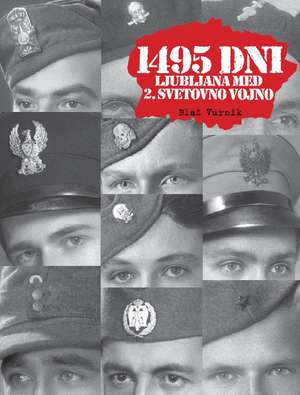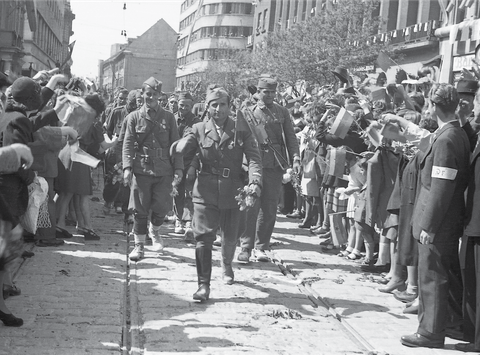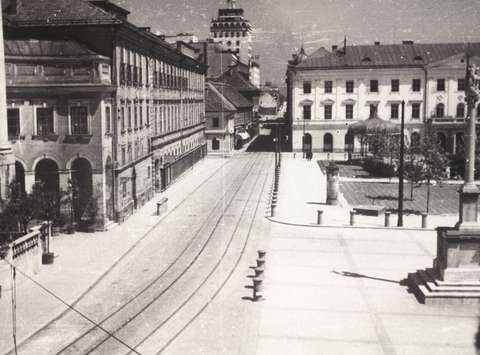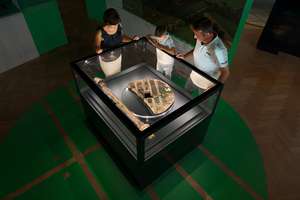1495 Days
Ljubljana During World War II
The exhibition, which marks the 80th anniversary of the end of World War II, presents the key events that took place in Ljubljana during the occupation. It highlights the everyday lives of residents during the war, their personal choices, the violence of the occupiers, and the organized resistance. Through individual stories, it reveals the difficult dilemmas people faced in the most challenging times and encourages visitors to reflect on peace, war, and the culture of nonviolence – themes that remain relevant to this day.
On the morning of April 6, 1941, Ljubljana woke up to Palm Sunday, but the day was soon disrupted by the sound of German aircraft. On April 11, the city was occupied by the Italian army, which immediately began a process of Italianization and repression. The occupation quickly transformed the city's appearance—shop windows and building facades were adorned with fascist symbols, and street names were changed to Italian. At first, Ljubljana seemed calm, but its inhabitants were already planning resistance. On April 26, the Anti-Imperialist Front of the Slovenian Nation was founded, and was later renamed to the Liberation Front of the Slovenian Nation (OF). Over time, the Communist Party acquired a leading role in it. The OF also established an active Security and Intelligence Service (VOS), carrying out intelligence activities and assassinations of political opponents and suspected collaborators in the city.
The Italian authorities responded to the resistance with terror— imprisonments, internments in concentration camps, executions of hostages, and the construction of a barbed-wire fence around the city. Their objective was to annihilate the Slovenian nation. At the same time, informal Village Sentry units were set up and were incorporated into the Italian occupation system as the Anti-Communist Voluntary Militia (Milizia volontaria anticommunista – MVAC). Militia members performed certain policing tasks in and around Ljubljana, and also carried out checks at crossing points.
After Italy’s capitulation in September 1943, German forces occupied the city and incorporated the Province of Ljubljana into the Operational Zone of the Adriatic Littoral. Mayor Leon Rupnik organized the Slovenian Home Guard, which collaborated with the occupiers. At the beginning of 1945, the Germans intensified their pressure on the resistance movement. The city suffered severe shortages, and after four years, the war was nearing its end. In early May 1945, German and Home Guard units began retreating, and on May 9, the city was liberated by partisan army.
Katalog je izšel ob odprtju razstave 1495 dni: Ljubljana med 2. svetovno vojno, s katero v Mestnem muzeju Ljubljana obeležujemo 80. obletnico konca 2. svetovne vojne.
Colophon
Museum and Galleries of Ljubljana, represented by Blaž Peršin, Director
Creator of the exhibition: Dr Blaž Vurnik
Project manager: Maja Kovač
Exhibition production: Maja Kovač, Ana Kure
Graphic design and exhibition layout: Vadim Fishkin, Miran Mohar, Darko Pokorn
Materials on display provided by: City Museum of Ljubljana, National Museum of Contemporary History od Slovenia
Video materials: (1) Members of the Slovenian Home Guard Swearing Allegiance at the Stadium in Ljubljana: produced by Emona film Ljubljana; materials kept by Film Archives at the Archives of the Republic of Slovenia, SI AS 1086 Film collection (2) Anti-communist National Rally in Kongresni trg: produced by Emona film Ljubljana; directed by Mario-Marijan Foerster; filmed by Rudi Omota; materials kept by Film Archives at the Archives of the Republic of Slovenia, SI AS 1086 Film collection (3) Ljubljana Welcoming its Liberators: produced by the State Film Company of the FNRY, Branch Office for Slovenia; written, directed and edited by Mario-Marijan Foerster; filmed by Metod Badjura, Janko Balantič, Rudi Omota; materials kept by Film Archives at the Archives of the Republic of Slovenia, SI AS 1086 Film collection (4) Underground Children – the Hidden Children of Occupied Ljubljana, full-length documentary film: directed by Marko Cafnik; written by Marko Cafnik, Blaž Vurnik; produced by Museum and Galleries of Ljubljana and RTV Slovenija, 2015
Photographs: the archives of Milena Kosec, City Museum of Ljubljana, National Museum of Contemporary History, Slovenian Ethnographic Museum, National and University Library
Music: Beniamino Gigli; Academic Choir, conducted by France Marolt, recorded by Rudi Omota, kept by Radio Slovenija
Conservation and restoration of the exhibits: Conservation Services of the MGML (Katarina Toman Kracina MA, Liza Lampič, Urh Tacar, Bojana Zavodnik), National and University Library, RTV Slovenija archives
Documentation: MGML Documentation Services (Martin Horvat, Gorazd Knific, Matej Satler)
Language editing (SLO): Katja Paladin
Translation into English: Marjana Karer
Language editing (ENG): Paula Kirby
Translation from Italian: Matic Šavli
Translation of audio and video content into English: Maja Lovrenov, Arven Šakti Kralj
View from the Other Side digital platform: Nejc Kovačič, Katarina Toman Kracina MA, Specto d.o.o.
QR code content: Liza Lampič
Exhibition equipment fabrication and installation: RPS d. o. o.
Technical layout: MGML Technical Services (Danilo Ončevski, Mitja Marc, Zvone Sečnik, Tomaž Žnidarčič, Jernej Volk), Ličer Solutions, d. o. o., RPS d. o. o.
Teaching programmes: Damjana Bergant, Ana Kure, Ema Marinčič, Janja Rebolj
Interactive content – concept: Damjana Bergant, Ema Marinčič, Blaž Vurnik
Interactive content – partners: Ana Bastl, Gregor Ožir, Matjaž Novak, Janez Polajnar
Audio stories: Library for the Blind and Visually Impaired, Dr Marko Stabej, Diego Capriolo, Jasmina Bejtovič, Lambda – Stanislav Zdešar, s. p.
Design and implementation of the On the Wings of Peace corner: Ema Marinčič, Damjana Bergant, Kresal Glassworks, Lene Lekše, Anya Ru, Knjižnica Otona Župančiča, Simona Solina
Design and implementation of the Save the Memory room: Ema Marinčič, Damjana Bergant, MGML Technical Services
Reproductions prepared by: Dora Janušič, PRIMA d.o.o.
Promotion: Tesa Arzenšek, Nejc Kovačič, Ana Kure, Urša Karer
Special thanks to: Miha Špiček and Blaž Verbič (Slovenian Ethnographic Museum); Andreja Zupanec Bajželj, Tina Fortič Jakopič and Marko Ličina (National Museum of Contemporary History), Mario Čolić (Hotel Occidental Ljubljana), Ana Modic
Location
Gosposka 15
1000 Ljubljana
Information and reservations:
T: +386 1 2412 500
T: +386 1 2412 506
E- mail: info@mgml.si, prijava@mgml.si
Opening hours
Tuesday–Sunday: 10.00–18.00
Mondays, 1 January, 1 November and 25 December: Closed
Tickets
Adults: € 8,00
Reduced*: 6,00 €
Family: 18,00 €
Free: ICOM, PRESS, SMD, URBANA tourist card holders, disabled persons, licensed tourist guide
We recommend buying a combo ticket for the Ljubljana City Museum and the Emona Archaeopark:
Adults: 10,00 €
Reduced: 8,00 €
Family: 22,00 €
Public guided tour
Adults: 9,00 €
Reduced*: € 7,00
Family: 18,00 €
Guided tour on a selected date (book your appointment at prijava@mgml.si)
Group of up to 7 persons: 70,00€
Group of up to 7 persons, discounted*: 55,00 €
Group of 8 or more persons: 9,00 €/adults, 7,00 €/reduced*
* seniors over 60, students, children and young people under 19, unemployed, disabled





